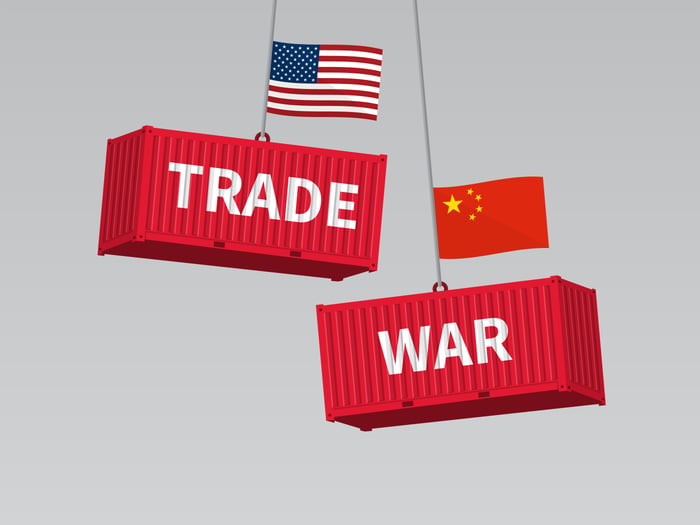Every day, Wall Street analysts upgrade some stocks, downgrade others, and "initiate coverage" on a few more. But do these analysts even know what they're talking about? Today, we're taking one high-profile Wall Street pick and putting it under the microscope...
From May 15 -- the date President Trump signed an executive order restricting sales of U.S. technology to Chinese 5G giant Huawei -- to the end of May, shares of computer memory maker Western Digital (WDC -1.77%) lost 18% of their value.
The good news is that Western Digital made up those losses in June. The better news is that now, one analyst is betting the stock can do even better on the prospect of a reversal of the Trump ban -- and maybe even a rollback in tariff barriers to trade between the U.S. and China.
Here's what you need to know.

Image source: Getty Images.
Headline news
On Saturday, President Trump announced plans to suspend tariffs on $300 billion in Chinese imports to the U.S. (Actually, in May he had threatened to impose tariffs on $325 billion in Chinese goods -- but to-may-to, to-mah-to. These are all really just negotiation points, not really policy until the negotiations have been completed.)
More importantly to Western Digital, Trump's announcement included a reprieve on sales of radio frequency microchips, computer memory, and other high-tech components sold by U.S. suppliers to Huawei where such sales pose "no great national security problem" to the U.S.
What it means to Western Digital
In an upgrade this morning, analysts at investment bank Mizuho argue that this latest twist in the trade war between America and China "effectively" takes Huawei "off the entity list" of foreign companies with which U.S. companies are unable to trade.
And because this trade ban has been a major overhang for Western Digital and its business of selling computer memory to Huawei, the analyst believes that "improving visibility, a rebound in orders and upside to depressed expectations" will now benefit Western Digital stock -- which Mizuho is upgrading to buy, with a $55 price target.
In the second half of 2019, Smarter Analyst notes that Mizuho is predicting an additional 50 million to 70 million Huawei handsets could be sold as a result of this development (in addition to developing 5G infrastructure, Huawei also sells cellphones), potentially incorporating memory from Western Digital. And Mizuho believes that "a more permanent resolution to the trade tariffs and more confidence in the supply chain should drive OEM restocking and normal demand and capex in 2020E."
Between falling inventory of NAND memory and output cuts at rival Micron, Mizuho is even predicting "a more rapid inventory adjustment" could begin as early as the December quarter of 2019, leading the analyst to forecast smaller-than-expected declines in NAND prices heading into 2020.
Caveats and provisos
And I have to say that all of this does appear to bode well for Western Digital stock, which at a price of less than 11 times free cash flow (with a 4.2% dividend yield and a 10% projected growth rate) doesn't look especially expensive on the surface.
A couple of caveats do bear mentioning, however.
First, debt. S&P Global Market Intelligence data show Western Digital carrying about $6.9 billion more debt than cash on its balance sheet, sufficient to push the company's enterprise value up to $20.8 billion, and therefore its enterprise value-to-free-cash-flow ratio up to 16 -- a less compelling bargain.
And second, part of the reason for this less attractive valuation is the fact that Western Digital stock has already rebounded strongly from the lows it plumbed at the end of May in the immediate wake of President Trump's executive order. Indeed, at a recent share price approaching $49, Western Digital has already recovered the losses suffered from the trade spat -- and more.
Why has this happened? Perhaps because investors are beginning to realize that Trump's trade ban wasn't quite as airtight as initially reported. Mizuho notes that "real clarity on supply chain relocations and production sourcing is still limited," an apparent reference to reports in the media on how "transshipment" of goods via third countries not directly affected by the executive order may be enabling companies like Western Digital to work around trade bans by selling to someone other than Huawei, who then proceeds to resell to Huawei.
Mostly, these reports focus on Chinese exports going to Vietnam to be rebranded as "Made In Vietnam" for re-export to the U.S. But logically, sales from U.S. tech companies to Vietnam or other buyers could just as easily wend their way in the other direction and end up in China. If that's the case, it would explain both why Western Digital bounced back so quickly from the effects of the trade ban -- and why lifting the ban might not provide too much additional benefit for the stock.




